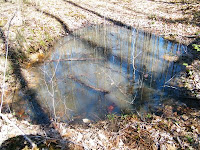
Vernal pool - a temporary body of water, usually appearing during the spring, devoid of fish and thereby allowing the development of amphibian and insect species.
We first noticed our vernal pool when we were looking at the house last year when we in the throes of house hunting. We referred to it as "the bog" back then, thinking that it would be a year-round fixture. My mom called it for what it was - a temporary body of water that serves as a watery incubator for a variety of species. And today, I saw it hard at work, setting the food chain into motion.
Our vernal pool is roughly 15' x 10' x 1', and forms in a large divot that runs parallel to the creek. In the late spring/early summer it dries up, leaving no indication of its function from February to April. The water is stagnant, and it serves an important role in our biome for three creatures.
First, the mosquitos. No surprise
 here, big stagnant pool of water means mosquito central. In one egg cluster, one mosquito will lay between 100-200 eggs. Think exponential growth. And in looking at the vernal pool, just beneath the surface were thousands, possibly tens of thousands of mosquito larvae, or "wrigglers" as we call them. They look like long specks of (something) in the water, except they bend in the middle and wriggle their way through the pool. Taken at face value, it's all pretty disgusting, right? Mosquitos are responsible for spreading a wide variety of diseases including Yellow Fever, Malaria and all kinds of encephalitis. The temptation to chemically treat the pool and wipe 'em out is kind of tempting.
here, big stagnant pool of water means mosquito central. In one egg cluster, one mosquito will lay between 100-200 eggs. Think exponential growth. And in looking at the vernal pool, just beneath the surface were thousands, possibly tens of thousands of mosquito larvae, or "wrigglers" as we call them. They look like long specks of (something) in the water, except they bend in the middle and wriggle their way through the pool. Taken at face value, it's all pretty disgusting, right? Mosquitos are responsible for spreading a wide variety of diseases including Yellow Fever, Malaria and all kinds of encephalitis. The temptation to chemically treat the pool and wipe 'em out is kind of tempting.But also in the pool are whitish globs that look like sunken snowballs or balls of cotton. Look
 closer and you'll see small black dots in the center of the sphere. Using a stick to pull one closer, we pulled a tennis-ball sized mass out of the water and identified it as a cluster of eggs. There are roughly 20 eggs per ball and a total of five egg masses that can be seen in the pool. Within a few more days, the eggs will hatch, and there's a good chance that the creatures that come out of the eggs may be snacking on the larvae.
closer and you'll see small black dots in the center of the sphere. Using a stick to pull one closer, we pulled a tennis-ball sized mass out of the water and identified it as a cluster of eggs. There are roughly 20 eggs per ball and a total of five egg masses that can be seen in the pool. Within a few more days, the eggs will hatch, and there's a good chance that the creatures that come out of the eggs may be snacking on the larvae.And now, the new facts: My first impression on seeing this egg casing is that we were looking at frog eggs. A little searching on the interwebs reveals that these may instead be eggs of the spotted salamander, which - - like other amphibians - - live the first part of their life in water and then adapt for life on land.
Since last summer, we've had several encounters with spotted salamanders, mostly when moving logs. Last fall, as we were picking up some rotten firewood, I let out a shout when I saw a 7" spotted salamander. Minutes later, I hollered again, having discovered another one, same size and markings as the first. Big Red took some photos of the find and entered them in a local arts competition, ultimately winning judges recognition for his work. His shots of our salamanders are below. In the coming weeks, we'll check in on these guys as they hatch and develop. To make this easier, we've filled a glass tank with some of the pool water (yes, mosquito larvae and all) and can watch as they grow. We'll eventually return them all to the pool, but can't wait to see what comes out.
In the coming weeks, we'll check in on these guys as they hatch and develop. To make this easier, we've filled a glass tank with some of the pool water (yes, mosquito larvae and all) and can watch as they grow. We'll eventually return them all to the pool, but can't wait to see what comes out.
 In the coming weeks, we'll check in on these guys as they hatch and develop. To make this easier, we've filled a glass tank with some of the pool water (yes, mosquito larvae and all) and can watch as they grow. We'll eventually return them all to the pool, but can't wait to see what comes out.
In the coming weeks, we'll check in on these guys as they hatch and develop. To make this easier, we've filled a glass tank with some of the pool water (yes, mosquito larvae and all) and can watch as they grow. We'll eventually return them all to the pool, but can't wait to see what comes out.
1 comment:
Cool, What's going on with the eggs? Have they hatched yet? What were they?
Post a Comment